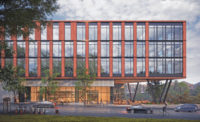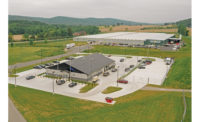The unpredictability of a coming presidential election can slow down construction markets, at least temporarily. But the industry appears to have emerged from this year’s unruly primary season unscathed. “Clearly we are going to get a new president, so that creates uncertainty in itself,” says Henry L. Lucas, president of Engineering Consulting Services Ltd., Chantilly, Va. “But interestingly enough, it doesn’t seem to have a negative effect.”
|
Click Here to View the 2016 ENR Mid-Atlantic Top Design Firms of the Year |
Lucas says his firm’s new project proposal volume in the Mid-Atlantic area has risen 8.1% and new project registrations in the region are up 10.4% in the 12 months ended May 15. “I don’t see anything right now that would suggest that that’s going to be much different over the near term in particular,” he says.
Results of the ENR MidAtlantic 2016 Top Design Firm survey support Lucas’ calculus. The region—Delaware, Maryland, Pennsylvania, Virginia, Washington, D.C., and West Virginia–remains busy. The 83 participating firms reported a total $4.04 billion in work performed and billed in 2015. That’s a 5% bump above last year’s $3.85 billion.
Transport Hub
Almost all of the top 10 firms on this year’s list saw their regional revenue increase from 2014. Eight of the top 10 firms said transportation produced more 2015 revenue than any other sector. Another 18 firms outside the top 10 reported transportation as their top segment.
For example, Baltimore-based EBA Engineering Inc. is providing construction management, inspection and materials-testing services for the Dulles Corridor Metrorail Project’s second phase. In aviation, AECOM’s portion of the $105-million Baltimore Washington International Thurgood Marshall Airport Terminal Connector helped the firm’s overall Mid-Atlantic revenue jump 4% in 2015, to $640.9 million.
Firms were busy with non-transportation projects, too. Philadelphia-based Pennoni’s 2015 revenue soared 24%, to $136.5 million, thanks in part to its work on the $500-million Procter & Gamble distribution facility in Berkeley County, W. Va.
Mixing It Up
Many firms in this year’s survey broke ground on significant mixed-use developments, including the $1.3-billion Capitol Crossing project in Washington, D.C. Dewberry, which reported $133.89 million in 2015 revenue, is working on the project, which includes 2.2 million sq ft of space on a seven-acre site.
Gensler, whose revenue jumped to $117.5 million from $95 million, is working on another mixed-use project in the District of Columbia. The $144-million Hine Project reconnects the Eastern Market Metrorail station and the historic Eastern Market with 158 residential units, including 46 affordable units. There also will be specialty shops, boutiques, restaurants, a landscaped plaza, office space and underground parking.
Activity in the ’Burbs
Urban-type developments that provide facilities for their residents to live, work and play are also branching into the suburbs of Washington, Baltimore and Philadelphia.
Nowhere is that trend more evident than Tysons Corner in northern Virginia, where 42 million sq ft of office, residential and commercial space is underway near four new Metro stops. Tysons’ largest project is the new Capital One Bank headquarters. The 470-ft-tall building, which WSP | Parsons Brinckerhoff is working on, would be the second-tallest structure in the area. Only the Washington Monument is higher. The complex will include residential units and a Wegmans supermarket.
‘Hacking’ Office Buildings
Gensler’s managing director in Washington, D.C., Jordan Goldstein, says the urbanizing movement also includes retrofitting existing buildings to meet the needs of tech companies and the millennial workforce. Gensler recently converted the former Syrup King Molasses building in south Baltimore into offices for Planit, a digital marketing agency. The company moved from traditional office space in Baltimore’s Inner Harbor to wide-open collaborative spaces in its new 30,000-sq-ft headquarters.
Goldstein likens this type of renovation to “hacking” a structure to “make older office buildings more friendly to today’s needs, [with] connecting stairs, double-height spaces and shallow core-to-window-wall depths, so more light penetrates the space.”









Post a comment to this article
Report Abusive Comment